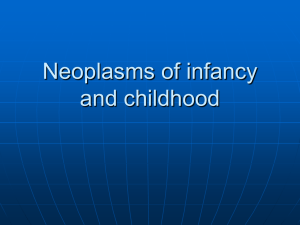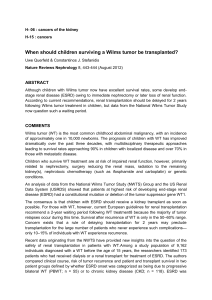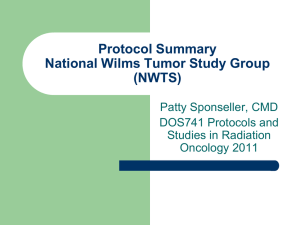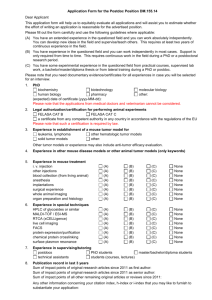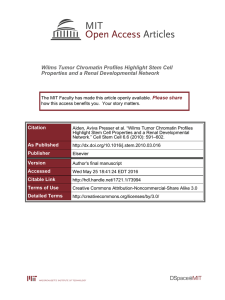Conclusions. Global gene expression was highly concordant between WT xenografts
advertisement
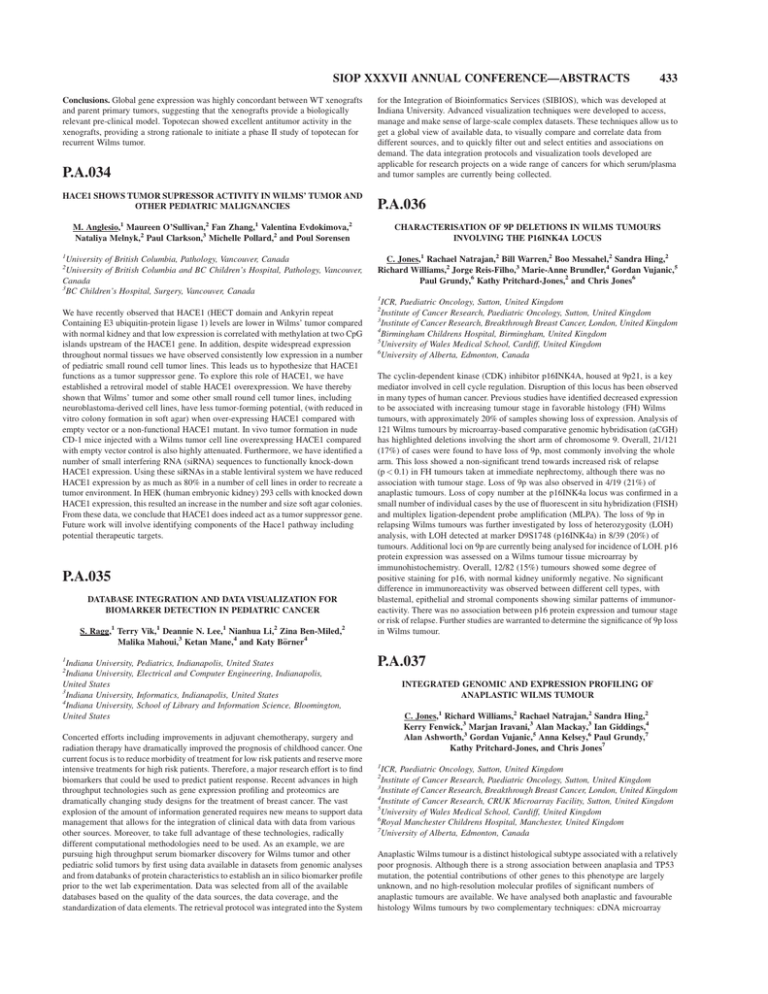
SIOP XXXVII ANNUAL CONFERENCE—ABSTRACTS 433 P.A.034 for the Integration of Bioinformatics Services (SIBIOS), which was developed at Indiana University. Advanced visualization techniques were developed to access, manage and make sense of large-scale complex datasets. These techniques allow us to get a global view of available data, to visually compare and correlate data from different sources, and to quickly filter out and select entities and associations on demand. The data integration protocols and visualization tools developed are applicable for research projects on a wide range of cancers for which serum/plasma and tumor samples are currently being collected. HACE1 SHOWS TUMOR SUPRESSOR ACTIVITY IN WILMS’ TUMOR AND OTHER PEDIATRIC MALIGNANCIES P.A.036 Conclusions. Global gene expression was highly concordant between WT xenografts and parent primary tumors, suggesting that the xenografts provide a biologically relevant pre-clinical model. Topotecan showed excellent antitumor activity in the xenografts, providing a strong rationale to initiate a phase II study of topotecan for recurrent Wilms tumor. M. Anglesio,1 Maureen O’Sullivan,2 Fan Zhang,1 Valentina Evdokimova,2 Nataliya Melnyk,2 Paul Clarkson,3 Michelle Pollard,2 and Poul Sorensen CHARACTERISATION OF 9P DELETIONS IN WILMS TUMOURS INVOLVING THE P16INK4A LOCUS University of British Columbia, Pathology, Vancouver, Canada University of British Columbia and BC Children’s Hospital, Pathology, Vancouver, Canada 3 BC Children’s Hospital, Surgery, Vancouver, Canada C. Jones,1 Rachael Natrajan,2 Bill Warren,2 Boo Messahel,2 Sandra Hing,2 Richard Williams,2 Jorge Reis-Filho,3 Marie-Anne Brundler,4 Gordan Vujanic,5 Paul Grundy,6 Kathy Pritchard-Jones,2 and Chris Jones6 We have recently observed that HACE1 (HECT domain and Ankyrin repeat Containing E3 ubiquitin-protein ligase 1) levels are lower in Wilms’ tumor compared with normal kidney and that low expression is correlated with methylation at two CpG islands upstream of the HACE1 gene. In addition, despite widespread expression throughout normal tissues we have observed consistently low expression in a number of pediatric small round cell tumor lines. This leads us to hypothesize that HACE1 functions as a tumor suppressor gene. To explore this role of HACE1, we have established a retroviral model of stable HACE1 overexpression. We have thereby shown that Wilms’ tumor and some other small round cell tumor lines, including neuroblastoma-derived cell lines, have less tumor-forming potential, (with reduced in vitro colony formation in soft agar) when over-expressing HACE1 compared with empty vector or a non-functional HACE1 mutant. In vivo tumor formation in nude CD-1 mice injected with a Wilms tumor cell line overexpressing HACE1 compared with empty vector control is also highly attenuated. Furthermore, we have identified a number of small interfering RNA (siRNA) sequences to functionally knock-down HACE1 expression. Using these siRNAs in a stable lentiviral system we have reduced HACE1 expression by as much as 80% in a number of cell lines in order to recreate a tumor environment. In HEK (human embryonic kidney) 293 cells with knocked down HACE1 expression, this resulted an increase in the number and size soft agar colonies. From these data, we conclude that HACE1 does indeed act as a tumor suppressor gene. Future work will involve identifying components of the Hace1 pathway including potential therapeutic targets. 2 1 2 1 P.A.035 DATABASE INTEGRATION AND DATA VISUALIZATION FOR BIOMARKER DETECTION IN PEDIATRIC CANCER S. Ragg,1 Terry Vik,1 Deannie N. Lee,1 Nianhua Li,2 Zina Ben-Miled,2 Malika Mahoui,3 Ketan Mane,4 and Katy Börner4 1 Indiana University, Indiana University, United States 3 Indiana University, 4 Indiana University, United States 2 Pediatrics, Indianapolis, United States Electrical and Computer Engineering, Indianapolis, ICR, Paediatric Oncology, Sutton, United Kingdom Institute of Cancer Research, Paediatric Oncology, Sutton, United Kingdom 3 Institute of Cancer Research, Breakthrough Breast Cancer, London, United Kingdom 4 Birmingham Childrens Hospital, Birmingham, United Kingdom 5 University of Wales Medical School, Cardiff, United Kingdom 6 University of Alberta, Edmonton, Canada The cyclin-dependent kinase (CDK) inhibitor p16INK4A, housed at 9p21, is a key mediator involved in cell cycle regulation. Disruption of this locus has been observed in many types of human cancer. Previous studies have identified decreased expression to be associated with increasing tumour stage in favorable histology (FH) Wilms tumours, with approximately 20% of samples showing loss of expression. Analysis of 121 Wilms tumours by microarray-based comparative genomic hybridisation (aCGH) has highlighted deletions involving the short arm of chromosome 9. Overall, 21/121 (17%) of cases were found to have loss of 9p, most commonly involving the whole arm. This loss showed a non-significant trend towards increased risk of relapse (p < 0.1) in FH tumours taken at immediate nephrectomy, although there was no association with tumour stage. Loss of 9p was also observed in 4/19 (21%) of anaplastic tumours. Loss of copy number at the p16INK4a locus was confirmed in a small number of individual cases by the use of fluorescent in situ hybridization (FISH) and multiplex ligation-dependent probe amplification (MLPA). The loss of 9p in relapsing Wilms tumours was further investigated by loss of heterozygosity (LOH) analysis, with LOH detected at marker D9S1748 (p16INK4a) in 8/39 (20%) of tumours. Additional loci on 9p are currently being analysed for incidence of LOH. p16 protein expression was assessed on a Wilms tumour tissue microarray by immunohistochemistry. Overall, 12/82 (15%) tumours showed some degree of positive staining for p16, with normal kidney uniformly negative. No significant difference in immunoreactivity was observed between different cell types, with blastemal, epithelial and stromal components showing similar patterns of immunoreactivity. There was no association between p16 protein expression and tumour stage or risk of relapse. Further studies are warranted to determine the significance of 9p loss in Wilms tumour. P.A.037 INTEGRATED GENOMIC AND EXPRESSION PROFILING OF ANAPLASTIC WILMS TUMOUR Informatics, Indianapolis, United States School of Library and Information Science, Bloomington, Concerted efforts including improvements in adjuvant chemotherapy, surgery and radiation therapy have dramatically improved the prognosis of childhood cancer. One current focus is to reduce morbidity of treatment for low risk patients and reserve more intensive treatments for high risk patients. Therefore, a major research effort is to find biomarkers that could be used to predict patient response. Recent advances in high throughput technologies such as gene expression profiling and proteomics are dramatically changing study designs for the treatment of breast cancer. The vast explosion of the amount of information generated requires new means to support data management that allows for the integration of clinical data with data from various other sources. Moreover, to take full advantage of these technologies, radically different computational methodologies need to be used. As an example, we are pursuing high throughput serum biomarker discovery for Wilms tumor and other pediatric solid tumors by first using data available in datasets from genomic analyses and from databanks of protein characteristics to establish an in silico biomarker profile prior to the wet lab experimentation. Data was selected from all of the available databases based on the quality of the data sources, the data coverage, and the standardization of data elements. The retrieval protocol was integrated into the System C. Jones,1 Richard Williams,2 Rachael Natrajan,2 Sandra Hing,2 Kerry Fenwick,3 Marjan Iravani,3 Alan Mackay,3 Ian Giddings,4 Alan Ashworth,3 Gordan Vujanic,5 Anna Kelsey,6 Paul Grundy,7 Kathy Pritchard-Jones, and Chris Jones7 1 ICR, Paediatric Oncology, Sutton, United Kingdom Institute of Cancer Research, Paediatric Oncology, Sutton, United Kingdom 3 Institute of Cancer Research, Breakthrough Breast Cancer, London, United Kingdom 4 Institute of Cancer Research, CRUK Microarray Facility, Sutton, United Kingdom 5 University of Wales Medical School, Cardiff, United Kingdom 6 Royal Manchester Childrens Hospital, Manchester, United Kingdom 7 University of Alberta, Edmonton, Canada 2 Anaplastic Wilms tumour is a distinct histological subtype associated with a relatively poor prognosis. Although there is a strong association between anaplasia and TP53 mutation, the potential contributions of other genes to this phenotype are largely unknown, and no high-resolution molecular profiles of significant numbers of anaplastic tumours are available. We have analysed both anaplastic and favourable histology Wilms tumours by two complementary techniques: cDNA microarray
